Wehrmacht belt buckles (description, types, identification of finds+)
I continue the topic on the Wehrmacht, identification of finds, in the first part we had a topic about Wehrmacht bowlers from the Second World War, what types were there and how to identify: Wehrmacht Bowler Kochgeschirr 31 (Identification of finds, options+) If you haven’t seen or read it yet, I recommend it, we’ll know what to dig up.
Now I would like to tell you more about the belt buckles of the Wehrmacht and only the Wehrmacht, because in the Third Reich there were a lot of different organizations, both military and civilian, almost every organization had its own version of buckles, but when we dig into the war, we most often come across standard ones yarn of the Wehrmacht, ordinary infantry. We will consider the topic of buckles of other organizations separately. So, let's go!
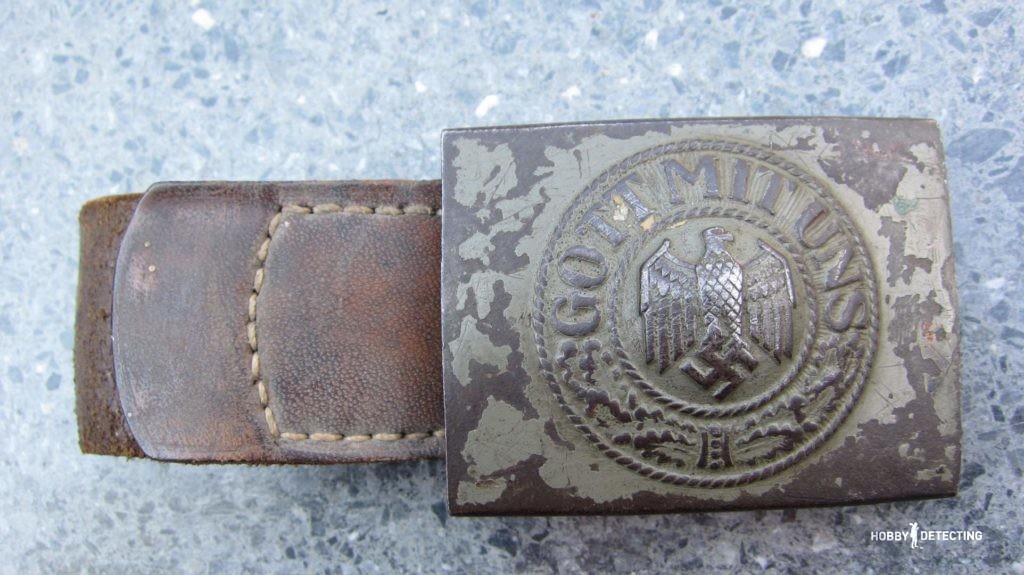 On the buckles of all the armies of the world, symbols of nationality are usually indicated; in the Third Reich, Germany, a swastika and an eagle were very often present on the buckles – this is especially true for state paramilitary organizations and branches of the military, an eagle with a swastika in a wreath of oak branches, clamped in the claws of the paws, called Hoheitzeichen (National Symbol).
On the buckles of all the armies of the world, symbols of nationality are usually indicated; in the Third Reich, Germany, a swastika and an eagle were very often present on the buckles – this is especially true for state paramilitary organizations and branches of the military, an eagle with a swastika in a wreath of oak branches, clamped in the claws of the paws, called Hoheitzeichen (National Symbol).
There is an opinion that the rotation of the eagle’s head indicates the affiliation of the organization: in government organizations in Germany the eagle’s head was turned to the left, and in party organizations it was turned to the right when looking at the eagle. However, the early Wehrmacht buckle is considered rare, because the eagle's head on it is turned to the left, and this was the case on soldier buckles up to and including 1935.
Early version of the buckle
Содержание статьи:

An early version of the Wehrmacht buckle before 1935.
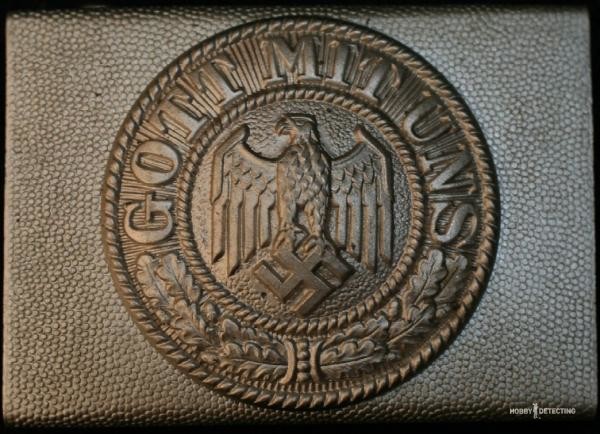 Another early option. The rotation of the eagle’s head in the “left” direction is clearly visible.
Another early option. The rotation of the eagle’s head in the “left” direction is clearly visible.
 Back side of an early buckle.
Back side of an early buckle.
Also for early Wehrmacht buckles – there are various kinds of alterations into a new version of all sorts of Reichswehr buckles (German armed forces before Hitler came to power), etc. Example:
 Remade from a Reiskhver buckle. The eagle's head is turned to the left.
Remade from a Reiskhver buckle. The eagle's head is turned to the left.
 An interesting rare specimen.
An interesting rare specimen.
As with all military equipment, the buckles had their own size, the standard size for rectangular buckles is 65x45mm, 50×35, buckles measuring 60×40 mm are less common.
Standard version after 1935
After 1935, the eagle's head was turned in the other direction, now to the right, and mass production of buckles for the Wehrmacht began. After all, in 1935, Germany found itself with a free hand, the terms of the Treaty of Versailles lost their force and the Wehrmacht began to grow. All buckles for the Wehrmacht were produced and supplied by private companies, which is interesting! To control the quality and standardize the products supplied by various private companies (and there were more than a hundred of them!), it was decided to place all orders for buckles through one person (a good feeder for making money) – the organization ReichsZeugMeisterei (abbreviated RZM), which was created on April 1, 1929 year with one task – monitoring the process of supplying uniforms and ammunition to NSDAP units. Subsequently, the main task of the organization became procurement and quality control with private manufacturing companies. Since 1935, each contract received its own number and from that moment on, the RZM mark appeared on Wehrmacht buckles, so the RZM mark was henceforth presented on every buckle. The mark was applied either on the finished product, or was included in the design of the stamping matrix. From time to time you come across specimens with the manufacturer's mark, but this is a non-standard option.
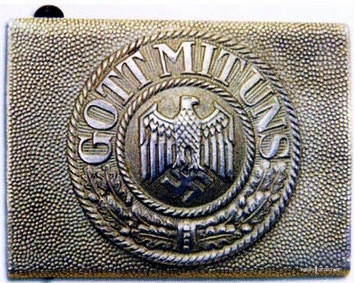
Standard buckle version after 1935.
In general, there are a large number of varieties of pre-war and military buckles, because with more than a hundred manufacturing companies it is always difficult to get the same standard version, so the differences come in the shape of the eagle (the head, wings, paws, etc. may differ), oak branches and so on. The buckle field could be either grainy or smooth. The buckle featured a round medallion in the center of which was placed an imperial eagle holding a swastika surrounded by oak leaves and the traditional motto of the German army – “Gott mit Uns” – “God is with us.”
There was also a separate version of the tropical buckle for the Wehrmacht Afrika Korps, but similar buckles were also found among units fighting in the Caucasus and Crimea.

Option for the tropics. Olive green steel buckle.
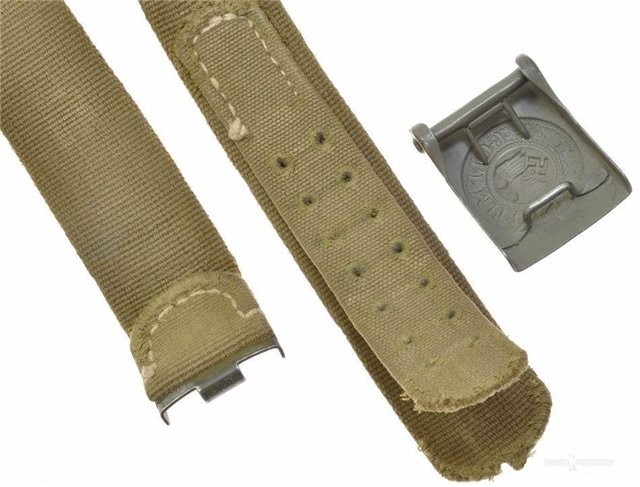
With the outbreak of World War II, there was an acute shortage of aluminum and buckles for the Wehrmacht began to be made from steel (since 1939). And already in September 1944, when Germany was approaching a slow but very logical end, it became much more difficult to supply a huge army on all fronts and it became increasingly difficult for RZM to exercise control over production, which led to permission for manufacturing companies to supply their products directly to the customer , bypassing the RZM contract system. Permission for direct deliveries was issued in December 1944, a few months before the end of the Reich.
Since the end of 1944, buckles began to be produced even from bakelite! The bakelite version of the buckle is currently very rare.

Wehrmacht bakelite buckle
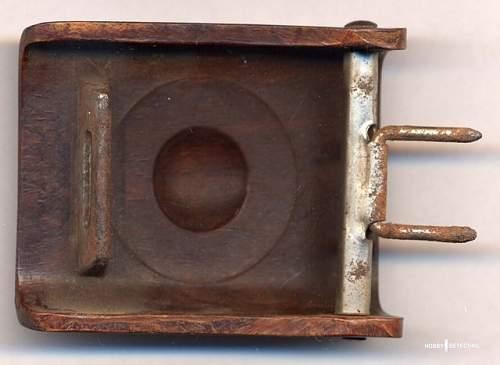
According to one version, the so-called “ersatz koppelschloss des Heer” was used mainly to equip Volkssturm units and Wehrmacht auxiliary/reserve units.
However, many experts on the issue of Wehrmacht equipment and uniforms have questioned this version and most likely this is the second version, which I myself adhere to, the bakelite buckle is nothing more than a prototype that did not go into production for certain reasons.
Wehrmacht buckle marks
Since the number of registered manufacturers of state symbols and awards in the Third Reich exceeded one hundred, all manufacturers had to be somehow codified, which was done. All manufacturers are coded using two systems – this is the company number in the state register of manufacturers and the company number in the register of authorized manufacturers of party and state symbols RZM (ReichsZeugMeisterei). According to the regulations, the RZM mark on a buckle begins with the code of the register of manufacturers of metal symbols (letter “M”), the section number of the register of manufacturers, namely for buckles – “4”, and through a slash “/” – the manufacturer’s number according to the register, for example: “RZM M4/46”. Sometimes the buckle simply had the manufacturer’s logo, for example “HA” (company “HA Erbe” Schmalkalden). There may simply be a manufacturer’s number according to the registry, with the RZM logo in a circle “RZM 46”. Or the manufacturer's logo with the DRGM logo – the old state system for registering and patenting symbol manufacturers. Various combinations of symbols (“DRGM RZM 257/41 SS”) may be present, or the patent protection mark “Ges.Gesch.” may be present. (Gesetzlich Geschutz). Or stand the manufacturer’s logo and code – “A 39”. Often the buckles are not branded at all. Stamps are usually convex, a little less common are “driven in” (usually on steel, due to the low ductility of the material).

List of Wehrmacht buckle manufacturers
Click to enlarge the text – list of Wehrmacht buckle manufacturers.
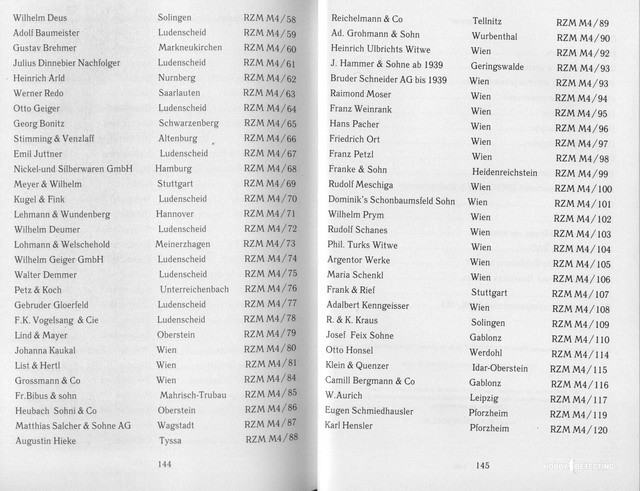
List of Wehrmacht buckle manufacturers part 2
And options with the manufacturer's mark and logo.
 The list is incomplete, unfortunately, if anyone has anything to add, write or add to the comments. It will also be great if you post photos from your finds or your collection.
The list is incomplete, unfortunately, if anyone has anything to add, write or add to the comments. It will also be great if you post photos from your finds or your collection.
I hope that it will help you in some way in identifying the Wehrmacht buckle you found or purchased! An interesting and pleasant find!
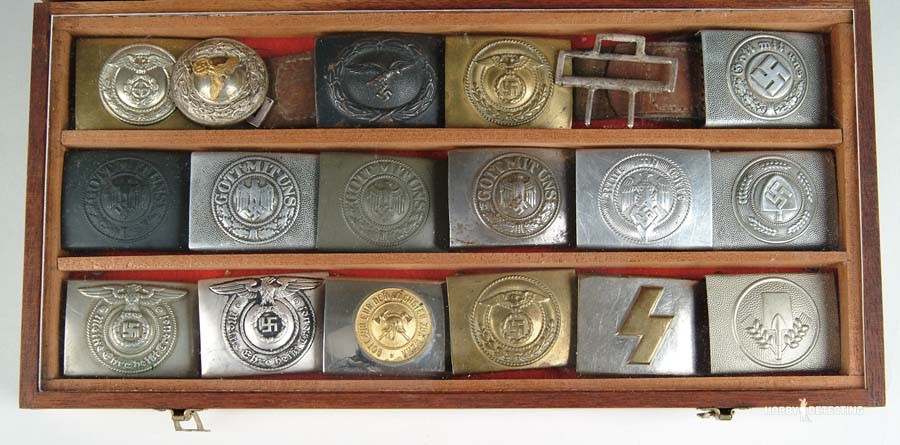 I wish everyone such a collection!
I wish everyone such a collection!
We write more about identifying various finds here , and everything about the war is collected here . Read, comment, share with friends!
